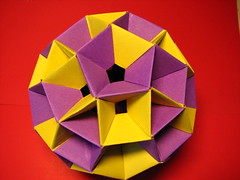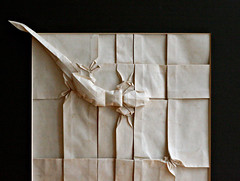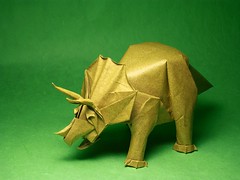
Folding Paper
-

- “Hamiltonian circuit on a rhomb-icosi-dodecahedron modular origami implementation.” (Francesco De Comite / CC BY)
Some of the best documentaries burrow deep into a relatively unknown subculture and manage to elucidate what makes this community distinct, beautiful, compelling, a world unto itself. Think of Errol Morris’ chronicle of strange obsessions, Fast, Cheap & Out of Control, in which he examines the similarities between a lion tamer, a topiary gardener, a mole rat researcher, and a roboticist. I was struck dumb by just such a documentary while on vacation this week, when I stumbled upon Between the Folds, a documentary about origami on PBS, part of that channel’s Independent Lens series.
Vanessa Gould’s documentary casts origami, or paper folding, as a multivalent art form long confined to simple designs, like cranes, but now coming of age with a wide range of immensely complex constructions—works of art requiring two hundred folds or more. The seminal figure in this transformation was Akira Yoshizawa, who quit his factory job and lived indigently so that he could devote himself to the study of origami. Over decades he elevated the craft to previously unconsidered heights, and most of the paper folders interviewed by Gould cite Yoshizawa as the progenitor of modern origami. Yoshizawa created the technique of wet folding—dampening paper to make it easier to fold—and also devised the graphical system now used to describe and chart steps for making origami, from basic cranes to thousand-scaled, reticulated dragons.
-

- “Origami Gecko.” (Kallu / CC BY-SA)
Between the Folds ranges widely, from combined origami-and-math lessons given to Israeli and Palestinian schoolchildren, to a well-established artist who, though an origami master, has begun paring down his designs to cruder forms, his evocative, druidic creatures now giving way to one-fold geometries. Gould visits with avant-garde French artists creating origami installations meant to model plant forms—including an inevitable decay. She meets teenage practitioners competing for the most folds in their designs; some of them, like the ardent paper folders who people various university math and physics departments, use computer modeling to develop new designs. There is also Erik DeMaine, a MacArthur Genius Grant recipient who became a professor of computer science at MIT at age 20. DeMaine, along with his sculptor father, has used origami to solve complex math problems and sees paper folding as a model of life itself: he argues that protein folding, that essential process by which a protein molecule assumes its three-dimensional shape and which is key to developing new drugs and matching diseases with their genetic antecedents, can be better understood by way of origami. Another origami artist shows that paper folding can be used to determine how to fold airbags and satellites to ensure they deploy properly (the artist, a former physics professor, was commissioned to design such a satellite).
-

- “Triceratops.” (Emre Ayaroğlu / CC BY)
The lesson through all of this is that this metamorphic art form is like no other. Nothing is added to the paper, nothing is taken away, cut, or torn. There are only folds upon folds—and required amounts of concentration, discipline, and time that make the most advanced of paper folders Buddhist in their meditative clarity of vision.
Independent Lens’ website features a quote from the New Yorker praising the documentary series as “like going to an independent bookstore—you don’t always find what you were looking for but you often find something you didn’t even know you wanted.” It’s this serendipitous quality, along with an omnivorous approach to society and culture, that has made Independent Lens’ documentaries great, from Between the Folds to Doc, which looks at Harold L. Humes, the brilliant and possibly insane novelist who was a founding editor of The Paris Review. (“He was one of the few people I have ever met who was essentially, at bottom, more vain, more intellectually arrogant, than I was,” Norman Mailer said of Humes.) I hope I stumble upon Independent Lens again, because each time I leave it unexpectedly enriched.
